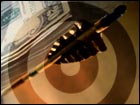|
Targeting stocks in 2002
|
 |
December 31, 2001: 6:04 p.m. ET
Strategists offer up a spectrum of targets for the S&P 500 in 2002.
By Staff Writer Vicki Zunitch
|
NEW YORK (CNN/Money) - The S&P 500 probably will rise 36 percent to 1,570 in 2002. No, wait! It probably will fall 17 percent to 950. Thus argued Wall Street strategists at the end of December 2001.
The wide range of expectations is a reminder that targets are just one of the instruments that belong in a savvy investors' toolkit. Only some, if any, of these strategists will prove right by the end of the year, and all have been wrong at some point in the past.
"I think you should pay attention to people's recommended asset allocation and you should put less emphasis on the targets," said Thomas McManus, chief investment strategist at Banc of America.
Nonetheless, McManus has set a target of 1,200 for the S&P 500, a rise of about 4 percent from Monday's closing price of 1,148. Why so stingy? Because he thinks stocks and bonds are pricing in a very robust recovery for which he has yet to see evidence.
You might call this view "Why pay now?" Observed McManus, "I think that later on we may be able to get the evidence of the recovery and we might be able to pay (for stocks) at the same price." Or, if there is no recovery, prices will come down and investors will be able to buy stocks at even more attractive discounts, he added.
McManus' recommended asset allocation, which he notes may require modification depending on individual circumstances, is now 55 percent stocks, 40 percent bonds, and 5 percent cash.
Abby Joseph Cohen of Goldman Sachs thinks it's important to know how a strategist arrived at a particular target. "Investors, whether they're individuals or professionals, should understand the assumptions behind the price targets," she said. Then they need to think about whether they agree with those assumptions, she added.
Cohen's 2002 target for the S&P 500 is a range of 1,300-to-1,425. Her primary assumptions are that growth in the economy and corporate profits will resume by the middle of the year.
Tobias Levkovich, the senior U.S. institutional equity strategist at Citigroup's Salomon Smith Barney, allows for a modest rise in the coming year to 1,350 for the S&P 500. The key to this target, he said, is earnings recovery. "We're going to shift from an interest-rate driven market to an earnings-driven market," he said.
Levkovich doesn't expect earnings growth to kick in until the second half of the year. "We actually believe first-quarter earnings will be down" on a year-over-year basis, followed by flat second-quarter results and 15-to-20 percent growth in the third and fourth quarters of 2002 and into 2003, he noted.
Nonetheless, Levkovich expects some disappointments along the way. "Our concern is that the expectations for technology-sector earnings are too aggressive," he said.
Levkovich thinks investors can best use targets to predict the direction of stocks - up or down - as opposed to leaning on them as absolutes. And he also notes that strategists often adjust targets, as they should, to fit new circumstances.
"Sept. 11 obviously changed everything," he said. "It was an out for everybody." Bulls had what he calls "an incredible excuse" to back away, and those that were bearish could claim prescience even though they couldn't have forecast at the beginning of the year the kind of damage stocks would sustain immediately after Sept. 11.
Levkovich, who started his job this year, had an S&P target of 1,400 on Sept. 10, which he lowered to 1,200 when the markets reopened on Sept. 17.
At Lehman Brothers, Jeffrey M. Applegate expects the S&P 500 to hit 1,350 by the end of the year. In a Dec. 14 report, Applegate and Lehman's Charles Reinhard forecast a 15 percent return for stocks, 5 percent for bonds, and 2 percent for cash.
The two analysts expect cyclical stocks, which are more sensitive to economic cycles and include such industries as retailing or financials, to outperform noncyclical stocks, which are less sensitive to economic cycles and include consumer products, as the market discounts a recovery in profits.
"Well into next year, we expect that a classic stock market recession rally will continue to unfold," Applegate and Reinhard say in the report.
UBS Warburg's Ed Kerschner has a target of 1,570, and JP Morgan's Douglas Cliggott has a target of 950. This leaves investors with a lot of homework to do in deciding with whom to agree. If Kerschner is right, the S&P will rise 36 percent, and if Cliggott is right, stocks will fall 17 percent.
For those that can't decide, Morgan Stanley's Steve Galbraith just about splits the difference between the two: He has set his target at 1,250. 
Click here to send mail to Victoria Zunitch
|
|
|
|
|
|

|

